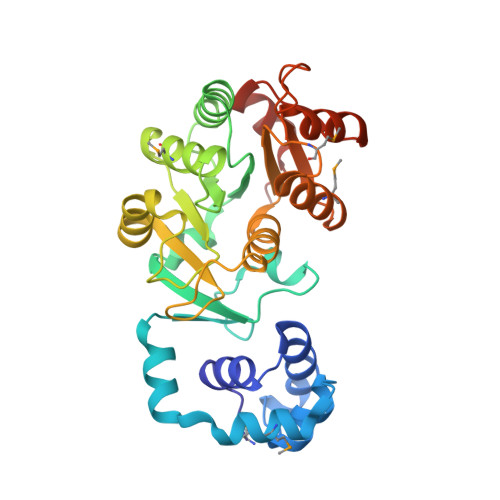Structure-function analysis of pneumococcal DprA protein reveals that dimerization is crucial for loading RecA recombinase onto DNA during transformation.
Quevillon-Cheruel, S., Campo, N., Mirouze, N., Mortier-Barriere, I., Brooks, M.A., Boudes, M., Durand, D., Soulet, A.L., Lisboa, J., Noirot, P., Martin, B., van Tilbeurgh, H., Noirot-Gros, M.F., Claverys, J.P., Polard, P.(2012) Proc Natl Acad Sci U S A 109: E2466-E2475
- PubMed: 22904190
- DOI: https://doi.org/10.1073/pnas.1205638109
- Primary Citation of Related Structures:
3UQZ - PubMed Abstract:
Transformation promotes genome plasticity in bacteria via RecA-driven homologous recombination. In the gram-positive human pathogen Streptococcus pneumoniae, the transformasome a multiprotein complex, internalizes, protects, and processes transforming DNA to generate chromosomal recombinants. Double-stranded DNA is internalized as single strands, onto which the transformation-dedicated DNA processing protein A (DprA) ensures the loading of RecA to form presynaptic filaments. We report that the structure of DprA consists of the association of a sterile alpha motif domain and a Rossmann fold and that DprA forms tail-to-tail dimers. The isolation of DprA self-interaction mutants revealed that dimerization is crucial for the formation of nucleocomplexes in vitro and for genetic transformation. Residues important for DprA-RecA interaction also were identified and mutated, establishing this interaction as equally important for transformation. Positioning of key interaction residues on the DprA structure revealed an overlap of DprA-DprA and DprA-RecA interaction surfaces. We propose a model in which RecA interaction promotes rearrangement or disruption of the DprA dimer, enabling the subsequent nucleation of RecA and its polymerization onto ssDNA.
Organizational Affiliation:
Institut de Biochimie et de Biophysique Moléculaire et Cellulaire, Université de Paris-Sud, Centre National de la Recherche Scientifique, Unité Mixte de Recherche 8619, Bât 430, 91405 Orsay Cedex, France. sophie.quevillon-cheruel@u-psud.fr
















